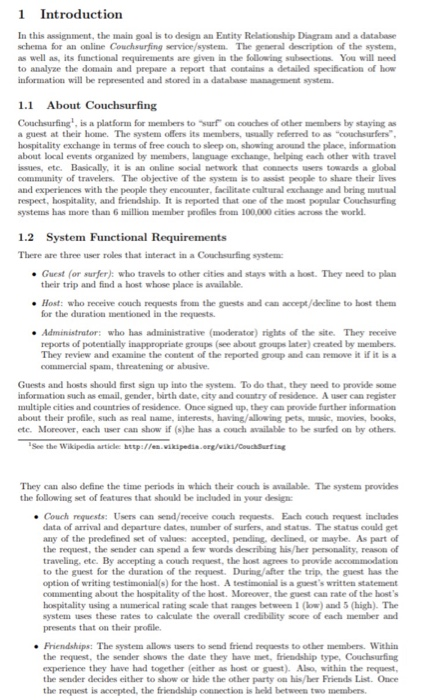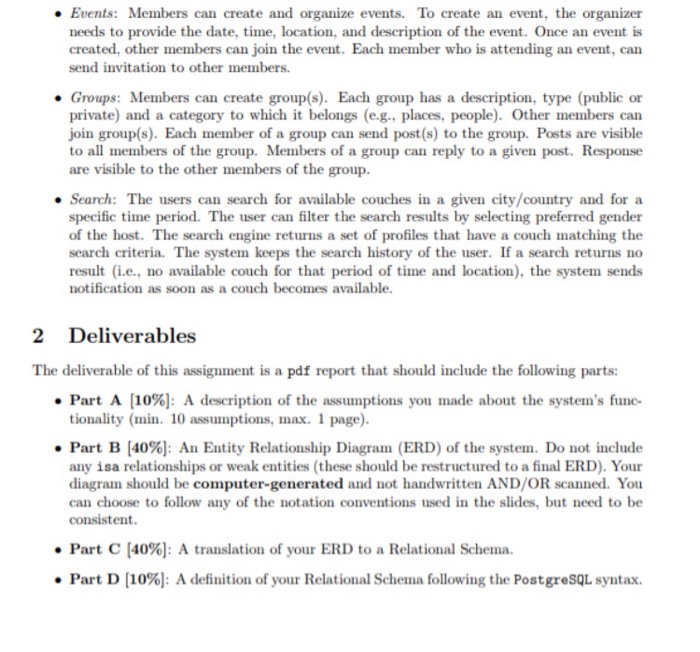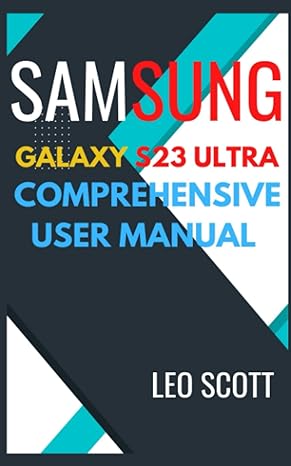ERD

1 Introduction In this assigament, the main goal is to design an Entity Relationship Diagram and a database schena for an online Couchsurfing service/systen. The geoeral description of the system as well as, its functional requirements are given in the following subsections You will need to analyze the domain and prepare a report that contains a detailed specification of how information will be represented and stored in a database management system. 1.1 About Couchsurfing Couchsurfing, is a platform for members to "surf on couches of other members by staying a guest at their hone. The system ofers its members, asally referred to as "couchesurfers hospitality exchange in terms of free couch to sleep on, showing around the place, information about local events organized by members, language exchange, helping each other with travel issues, ete. Basically, it is an online social network that conmects users towards a global community of travelers. The objective of the system is to assist people to share their lives and experiences with the people they encounter, facilitate cultural exchange and bring mutual respect, hospitality, and friendship. It is reported that one of the most popular Couchsurfing systems has more than 6 million member peofiles from 100,000 cities across the world. 1.2 System Functional Requirements There are three user roles that interact in a Couchsurfing system Guest (or surfer): who travels to other cities and stays with a host. They need to plan their trip and find a host whose place is available Host: who receive couch requests from the guests and can accept/decline to bost them for the duration mentioned in the requests Administrator: who has administrative (moderator) rights of the site. They receive reports of potentially inappropriate groups (see about groups later) created by members. They review and exanine the content of the reported group and can remove it if it is a commercial spam, threatening or abusive Guests and hosts should first sign up into the system. To do that, they meed to provide some information such as email, gender, birth date, city and country of residenoe. A user can register multiple cities and countries of residence Once signed up, they can provide further information about their profile, such as real name, interests, having/allowing pets, masic, movies, books ete. Moreover, each user can show if (s)be has a couch available to be sufed on by others See the Wikipedia article http://es.wikipedia.org/iki/CouchSurting They can also define the time periods in which their couch is available. The system peovides the following set of features that should be inclhaded in your desig . Couch reguests: Users can send/receive couch reqaests. Each couch request includes data of arrival and departure dates, number of surfers, and status. The status could get any of the predefined set of values: accepted, pending, declined, or maybe. As part of the request, the sender can spend a few words describing his/her personality, reason of traveling, ete. By accepting a couch request, the host agrees to provide accommodation to the guest for the duration of the request During/after the trip, the guest has the option of writing testimonial(s) for the host. A testimonial is a guest's written statement commenting about the hospitality of the bost. Moreover, the guest can rate of the host's hospitality using a umerical rating scale that ranges between 1 (low) and 5 (high). The system uses these rates to calculate the overall credibility score of each member and preseuts that on their profile. Friendships: The system allows users to send friend requests to other members. Within the request, the sender shows the date they have met, friendship type, Couchsurfing experience they have had together (either as host or guest). Also, within the request the sender decides either to show or hide the other party on his/her Friends List. Ouce the request is accepted, the friendship connnction is beld between two members. Events: Members can create and organize events. To create an event, the organizer needs to provide the date, time, location, and description of the event. Once an event is created, other members can join the event. Each member who is attending an event, can send invitation to other members Groups: Members can create group(s). Each group has a description, type (public or private) and a category to which it belongs (e.g., places, people). Other members can join group(s). Each member of a group can send post (s) to the group. Posts are visible to all members of the group. Members of a group can reply to a given post. Response are visible to the other members of the group . Search: The users can search for available couches in a given city/country and for a specific time period. The user can filter the search results by selecting preferred gender of the host. The search engine returns a set of profiles that have a couch matching the search criteria. The system keeps the search history of the user. If a search returns no result (i.e., no available couch for that period of time and location), the system sends notification as soon as a couch becomes available 2 Deliverables The deliverable of this assignment is a pdf report that should include the following parts: Part A [10%]: A description of the assumptions you miade about the system's func- tionality (min. 10 assumptions, max. 1 page . Part B [40%): An Entity Relationship Diagran (ERD) of the system. Do not include any isa relationships or weak entities (these should be restructured to a final ERD). Your diagram should be computer-generated and not handwritten AND/OR scanned. You can choose to follow any of the notation conventions used in the slides, but need to be consistent. . Part C [40%]: A translation of your ERD to a Relational Schena. Part D [ 10%]: A definition of your Relational Schema following the PostgreSQL syntax









